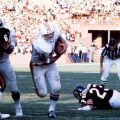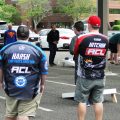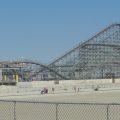Where’s The Love For Pocono Raceway?
When I covered NASCAR for the Frontstretch in the late 2000s, there were quite a few motorsports writers that had nothing good to say about the racing at Pocono Raceway in Long Pond, PA. I came to the speedway’s defense in this incisive and thoughtful column, which first appeared here on the Frontstretch website. Pocono is still today one of my favorite NASCAR venues.
Where’s The Love For Pocono Raceway?
In the world of motorsports commentary, there doesn’t seem to be a lot of affection for Pocono Raceway. The complaints are numerous. Boring, single-file racing and not enough passing. No gear shifting. Too big of a track. 500 miles is too long. Can’t see what’s going on near the tunnel turn from the seats. Too long to get out of the parking lot. Waaah, waaah, waaah. Even the Wikipedia entry on the track bitches about it, citing “several drivers” (while naming only Denny Hamlin) and their antipathy for the place.
Our own Danny Peters, who is a first class motorsports writer in every other sense of the word, ranked Pocono just above Fontana in his evaluation of tracks on the NASCAR schedule.
The racing press has such a low opinion of Long Pond that when Bruton Smith purchased Kentucky Speedway and promised a Cup date there, it was immediately news that he might buy Pocono and move one of its Cup dates. Why suggest Pocono for a loss of a Cup date? Why not Dover, or Indianapolis? Why not an ISC track, like the favorite asphalted whipping boy for 95% of race fans – Fontana?
For all the moaning about Speedway Motorsports Inc. and International Speedway Corp. owning almost all of the tracks on the circuit, does Pocono Raceway get any points at all for being independently owned? When one thinks about the antitrust lawsuit that was brought by Kentucky Speedway against NASCAR some time ago, and how some who were tired of races being removed from classic tracks identified with Kentucky’s position, why would like thinkers be so eager to lose a date at Pocono to yet another SMI or ISC “D” speedway (“D” as in the shape of the track, not a letter grade for the general quality of racing at such venues, although it could apply), which Kentucky Speedway officially is now?
There wasn’t any discussion at all between Smith and Pocono Raceway owner Joseph Mattioli about a possible sale. Smith never gave any hint of desire to buy it. But Mattioli’s wife actually had to tell the press that Pocono was never nor ever will be available for sale. The possible move of a Cup date from Pocono to Kentucky wasn’t even a story… it was just a by-product of some reporters’ unquenchable desire for Pocono Raceway to lose a race.
So in contrast to the echo chamber denigrating Pocono Raceway, the Official Columnist of NASCAR speaks out here, in his ubiquitous Happy Hour forum, for the greatness of a speedway that gets an undeserved bad rap. I don’t care what anyone else thinks… Pocono rocks for a bunch of reasons.
Let’s start with the obvious. Pocono Raceway is a refreshing departure from those “D” tracks, the 1.5-2 mile speedways that now dominate way too much of the current NASCAR circuit. “Intermediates,” they are usually called. Among race fans, “cookie-cutters” is a more common euphemism.
Chicagoland, Texas, Michigan, etc., there’s no need to list them all, are the motorsports equivalent of the soulless, concrete doughnut, artificial turf, multipurpose baseball stadiums of the 1970s. Maybe someday racing will have its own Camden Yards to inspire a revival of taxpayer-subsidized old-style racetrack building, but for now we have few and shrinking alternatives. In a NASCAR schedule that features far too little variation among venues, Pocono stands out like a sore thumb, in a good way.
It isn’t even close to any other speedway. Look at decent tracks like Phoenix or Richmond even; yes, they’re different from the cookie-cutters and have some character, but they’re still D-shaped; they’re just smaller. It really doesn’t make for much difference to those in attendance.
Pocono, on the other hand, has three completely distinct turns instead of four equal ones. Each straightaway being a different length in the track’s scalene layout means that all of the turns are at different angles. How is the coolness of that missed? Pythagoras would have loved racing a chariot in this joint. For those of you who are weary of the constant lament from the unenlightened that “they just go around in circles”, at least Pocono offers a response to that. A circle, or even an oval, it is not.
The three turns themselves pay tribute to three classic tracks: turn 1 is modeled after the late Trenton Speedway, the tunnel turn (so named because of its location above the entry tunnel) is inspired by Indianapolis Motor Speedway, and turn 3 is similar to the Milwaukee Mile (another track that should have a Cup date).
Not only do the three turns give Pocono a nod to history, the different angles and banking of them gives crew chiefs fits. Before every Pocono race, teams can all be heard talking about “compromise” in their setups. You can be good in turn 1 and the tunnel turn, but you’ll pay for it in turn 3; and vice versa. Teams all attempt to be adequate on each turn because no one will be great on all of them. And the tunnel turn, with its sharp cornering and low banking, is often described as the most difficult in NASCAR for drivers.
It’s not just the turns that make Pocono Raceway so special and challenging. The track also features the circuit’s longest straightaway at 3,740 feet, almost three-quarters of a mile in length. The extra-long frontstretch makes for great drag races, especially on restarts, with cars racing three- and four-wide for that extra anxiety going into turn 1. But drivers had better break that side-by-side habit going into turn 2 or they aren’t going to finish the race.
Because of Pocono’s layout, teams need the whole package: horsepower, downforce, chassis setup, and a danged good wheelman driving the car. If they’re off on one corner, they’ll be in the back of the pack before very long. If the driver can’t negotiate the tunnel turn, they’ll be loading the car into the hauler before the race is over. Not enough horsepower for the drag race on the frontstretch and the team might as well stay home. And they had better not neglect to bring a super strong engine and a super durable set of brakes for 500 miles of this pounding. Many an engine has heartbreakingly expired at Pocono just 5-10 laps short of the checkered flag.
That’s my kind of grind. 500 miles on a 2.5-mile track without restrictor plates. Only at Pocono.
Occasionally, you’ll see just one driver’s team… it’s been Hamlin or Kurt Busch in recent years… totally nail the setup and dust the entire field. Pocono seems to be more conducive to such dominance, perhaps because of the difficulty of the setup. Having missed the Loudon race where Jeff Burton led every single lap, I have yet to see that feat accomplished, but I’m betting it will happen at Pocono before anywhere else. Some people will say one driver dominating is boring. I think it’s about as boring as a ballgame where one team doesn’t get any hits.
There aren’t many tracks on the circuit where drivers can safely go 55 mph in the pits. Crew members probably prefer Pocono to Bristol or Martinsville. That should count for something. It’s not that fans want to see Martinsville leave the circuit…ever…but that is sometimes cited as a reason to axe the famed paper clip from the schedule. Most newer speedways feature safer, wider pit roads. Pocono already has one.
Pocono Raceway is wide open, unsaturated with extra seats with low-quality views everywhere as so many tracks are these days. On television, most of the camera views contain greenery in the background rather that greed-inspired grandstands. That and its location in a truly rural area of Pennsylvania makes Pocono a throwback to a traditional era of NASCAR.
Since all of the seats at Pocono are on the frontstretch, fans are treated to the gradually rising volume of the engines as the cars work towards turn 3, before they scream down the frontstretch in an earsplitting roar. That, in this writer’s opinion, actually makes the distance of the tunnel turn from the grandstand a feature, not an impediment, of the fan experience. From quiet to deafening. It’s an oddity. Oddities are good.
There isn’t any shortage of spectacular wrecks either, if you’re into the more morbid side of racing. Remember Jeff Gordon’s brake failure and subsequent full-speed pounding into the wall in 2006? Or Steve Park’s scary flip in 2002?
So the complaints about Pocono are unreasonable. Not enough passing, you say? Daytona can have 30 passes in a lap. Two freight trains don’t make for better racing. The cars are too far from view going into the tunnel turn? If limited view for spectators is an issue, what the h is Indianapolis still doing on the schedule? No shifting gears? Gear shifting is for road courses. 500 miles is too long for a race? Don’t be such a candy ass, as The Intimidator would say. It’s racing for crying out loud. Too big of a track? Talladega is the same length and receives no such derision; and unlike ’Dega, Pocono doesn’t restrict horsepower, the practice of which remains the perfect antithesis of racing. Too long of a wait to get out of the parking lot? Where isn’t that a problem? At least at Pocono, loyal fans aren’t charged a double sawbuck to park in a field.
It’s baffling how many NASCAR fans and even writers, who call themselves traditionalists with no love for the France or Smith empires, never seem to lay off bashing one of the few unique, rural, throwback, independently owned racetracks left on the schedule.
Count the Official Columnist of NASCAR proudly in what appears to be the minority opinion: Pocono Raceway deserves every one of its 1,000 miles of racing.
Photo credit: CBGB_Hoser on Best Running / CC BY-ND
Photo credit: likeaduck on Best Running / CC BY
Photo credit: DOCHKAS on Best Running / CC BY
Photo credit: likeaduck on Best Running / CC BY
Photo credit: likeaduck on Best Running / CC BY
Photo credit: Mike Traverse on Best Running / CC BY-SA
Photo credit: On Pit Row on Best Running / CC BY-ND
Photo credit: DOCHKAS on Best Running / CC BY























